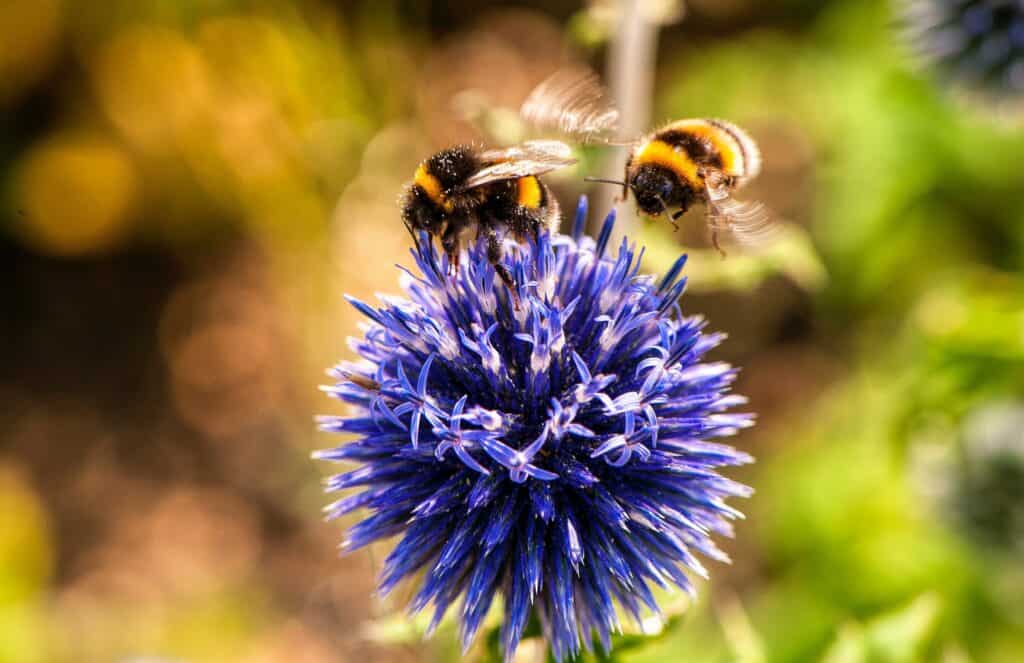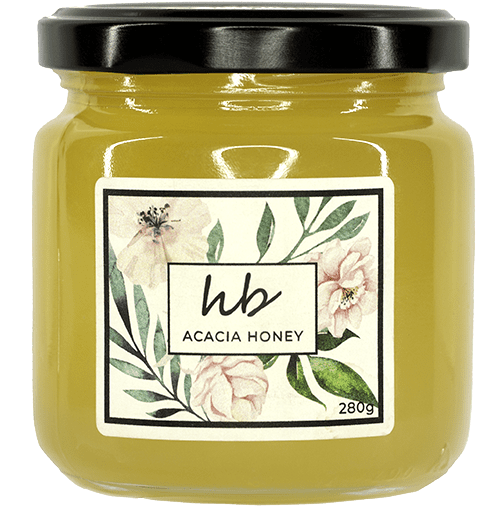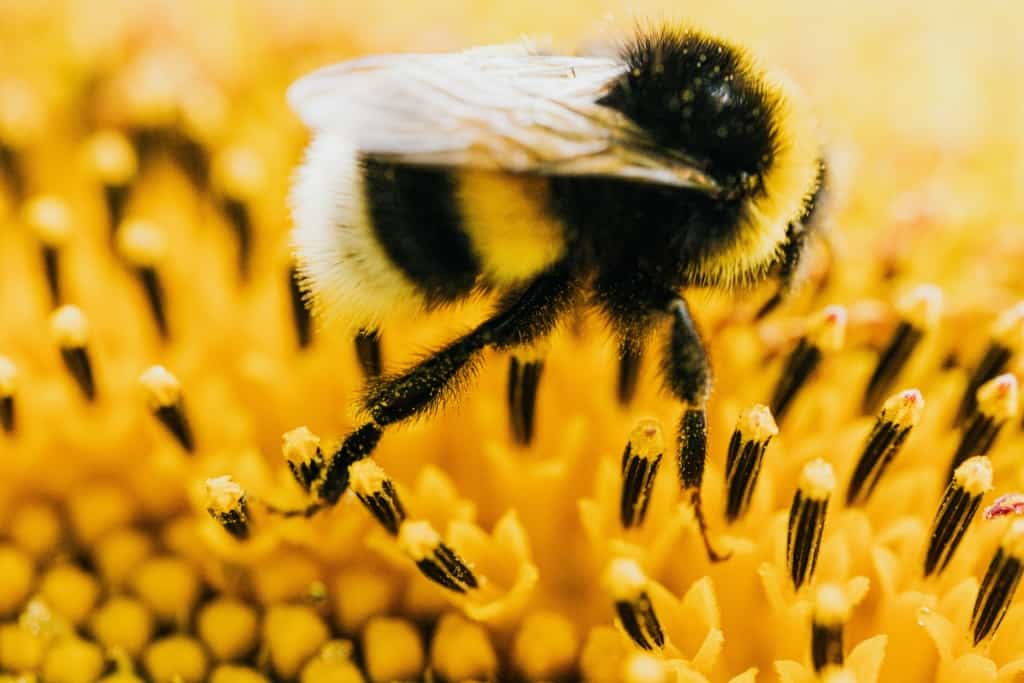Bumblebee – the basics
Bumblebee is a very common name for bigger, all-covered in hair, more often black and yellow bees. They are native to the areas with temperate climates in the Northern Hemisphere and often go further north and higher than other bees.
Bumblebees are close relatives to the honey bees and they also are ruled by a Mother Bee who lays eggs and have bee workers and male bees.
And even though they share a lot of similarities with the honey bees, the bumblebees are only thriving in the summer season. During the rest of the year, the young mother bees fall in a deep sleep only to wake up again in spring and start a new family.
In addition, the bumblebees create smaller families than the honey bees, with fewer individuals. Another very distinguished difference is that bumblebees don’t do the usual for the honey bees to dance when communicating with each other.
And because bumblebees have such an importance for nature, they are deeply researched by scientists and there are many known facts about them.
The bumblebees are one of the few bee species that can self-regulate their body temperature. If the temperatures drop, they use vibrations to heat their bodies and continue their working process. Their size and the fact that they are covered with hair also help them to keep a good temperature for life and work. These features help the bumblebees to live in Northern areas and Alpine heights.
A lot of bumblebee families have disappeared from England in the last ten years because of the adoption of agricultural lands.
Bumblebees belong to the family Bombus from the Apidae, class Hymenoptera.

Family life
The bumblebee hives have a shape of a sphere and one entrance which is also an exit. The Bee Mother is the one who chooses the space where the hive will settle. This for example could be an abandoned nest of a wood mouse, also known as a field mouse. Most bumblebees nest in the ground as the Mother Bee is the one who starts building a little bowl from pollen in the middle of the hive then lays eggs and seals them with wax.
She also builds a circle sphere of wax for honey which she positions at the front of the hive and fills with nectar. This nectar serves her as food during the time of the egg-laying. The newly hatched larvae would eat the dried pollen nectar they find around them until the mother starts feeding them. When they are fully grown the larvae form a cocoon in which they reach the final stage of their metamorphose development, which then leads to the appearance of the first bee workers of the new family.
The working bees will then take care of the next hatched larvae of the family which is identical to the honeybees’ hive life. One difference between the two bee types is that the honey bees’ hives contain flat vertical wax bars and the bumblebees organise their hives on a growing pile of cells.
At the end of the summer, the Mother Bee starts laying unfertilized eggs, from which are then the male bees hatched or also called drones. The newly hatched females will then become Queen Bees and are being fertilized after that.
There is a time when the bee workers and the drones die and the “mothers” fly away to search for a safe place for their winter sleep.
There is one variety of bumblebees known to nature that is a pest for the hives. The name is Cuckoo bumblebee. The Cuckoo bumblebee kills the social bumblebee queen and lays her own eggs in the nest. Therefore, the worker bumblebees without realising they are not related would raise the offspring of the cuckoo bumblebee.
Pollination
Bumblebees are crucial for the pollination of many flowers. The “mothers” and the workers gather pollen and transport it back to the family in pollen baskets on their back feet. The bee workers are smaller if born at the beginning of the year and bigger at the end of the year.
Another peculiarity of the bumblebee family is that there are bees born at the same time but with a different length of their proboscis which means they are specialised in pollinating different flower types.
It’s a well-known fact that bumblebees are an important component of the pollination process of different species of plants. Scientists have managed to create an artificial means which prevent the bumblebees from having their winter sleep so they can keep updating the families. This leads to pollinating flowers that they weren’t able to pollinate before.

Interesting facts
The world’s largest bumblebee is Bombus dahlbomii native to the Patagonia region of Argentina and Chile. The queens of this bee type can reach the whopping length of 40 mm, which is two times bigger than the regular bumblebee. Some even describe this bee as a “flying mouse”.
Stinging is not fatal for bumblebees. Bumblebees are not aggressive, they would only sting if they feel threatened. Unlike honey bees, they can sting multiple times and won’t die after that. Male bumblebees don’t have a stinger at all.
Bumblebees require a lot of food. Their metabolisms are extremely quick and they have to eat almost all the time. “A bumblebee with a full stomach is only ever about 40 minutes from starvation”, according to Dave Goulson, Professor of Biology at the Sussex University.
Bumblebee eggs have the shape of sausages. More like “micro sausages”.
It’s all about wing speed. Bumblebees flap their wings about 200 times per second. How incredible is that?
The queen bee carries bee sperm during her hibernation for months.
Bumblebees appear around 30 million years ago.
There are around 400 bumblebees in a hive compared to 50,000 in a honeybee hive.
Bumblebees aren’t always black and yellow. There are some species dressed in orange with white stripes. However, they are always hairy.
Like honeybees, bumblebees use their wings to cool down their nests.
Many people wonder how do the bumblebee body functions. Instead of arteries and veins, Bombus have one pool of blood where all of their organs sit together. However, their heart pulses blood through a long tube, which serves them as a circulatory system.
The bumblebee has five eyes. Three of them are located on the top of the head and the other two are on the front. Because of their multiple eyes, they can see UV light.
Interesting fact: Bumblebees can’t see the colour red.
Do Bumblebees Make Honey?
Bumblebees do collect nectar but do not transform it into honey.
Nectar is the main food source for bumblebees and this is the reason they collect it from the flowers. Just like honey for people, nectar is used by bumblebees for energy and strength. However, unlike the honeybees, they are rather selfish species and gather the nectars from the flowers only to eat them almost immediately after being stored in their hive. Therefore the nectar doesn’t go through the process of conversion into raw honey.

What happens if a Bumblebee stings you?
As we found out earlier in the article Bumblebees are not aggressive but will attack if they feel threatened. We also mentioned that only Queen bees and the workers have stingers and that drones, aka the male bees, do not have them.
If you happen to be stung by a bumblebee, a small amount of their venom is injected into the body through their stinger. In humans, this translates to a short severe pain that quickly fades away. An allergic reaction isn’t very likely to happen but it’s not impossible. However, if you are allergic to bees of any kind, seek help from a professional.
Bumblebees do not die after stinging, unlike honeybees. They can easily retract their stinger and sting again. So be alert and remove yourself from the area if stung once as another hit might happen. If stung more than once, this means that you have angered the bumblebee A LOT as they are the least aggressive bee kind.
How to heal a bumblebee stung?
A bumblebee sting usually creates swelling of the area, annoying itchiness and redness which lasts for a few hours. This can appear straight after the accident or later on as a result of it.
If an allergic reaction doesn’t occur medical treatment isn’t necessary. However, there are some measures that can be taken to prevent the uncomfortable effects of the sting. Depending on the area of the wound, there are different measures and timeframes that should be taken. If stung near the eyes, you should react immediately as the area is extremely sensitive and the irritation can lead to an extremely unpleasant experience and even worse aftereffects.
The first thing to be done in this case is for the person to take an anti-inflammatory medication, such as aspirin or ibuprofen. Then a cold compress should be applied to the wound to prevent and minimalize the swelling.
If the sting is on a part of the mouth like the tongue, for example, the person should immediately be taken to the nearest available hospital for treatment. Because once the swelling occurs, this could result in blocked airways and difficulty breathing.
If the sting is on a non-sensitive area and you have no access to medication, there are some home remedies used in the old times that could help the healing of the wound. However, before we give them away, make sure you make the best choice for the situation you are in and do not take any risks with your own health.
Home remedies for bee sting wounds:
The best and most effective of all home remedies is a cold compress. To do that, take a few cubes of ice or any frozen object from your freezer and wrap it in a towel. Then gently place it over the wound and hold for a few seconds until getting comfortable with the cold. Hold it on the skin for about 20 minutes straight after the sting to prevent itchiness and swelling.
Another great remedy for stings is the cucumber. Simply cut cucumber and press the inside to the wound. The cucumber will strengthen the skin and will soothe the pain.
Another natural product that could be used in this situation is a garlic clove. Grate one clove of garlic, make it into a paste and apply to the wound. Put plaster on top and let the garlic juices heal your wound.
Remember: If you feel any other symptoms from the above mentioned, and nothing works, and your condition is getting worse, do not hesitate to seek medical help.
No matter how insignificant it might seem; a bee sting could be dangerous and should not be neglected.
When working with bumblebees:
Avoid provoking them.
Be calm! After all, they are living creatures and very delicate ones as well.
Do not wave your arms around them.
Do not push their hive.
Do not try to touch or hold the bumblebee.
Be aware that they can get agitated by strong smells such as alcohol, deodorants, perfumes, scented soaps, aftershaves or any strong smell for that matter.
Bracelets, rings, watches and all similar accessories may create aggressive behaviour amongst the hive because of the scent of oxidised material between the skin and the jewellery.
Bumblebees’ favourite colour is blue and they are very attracted to light blue specifically.
Be aware that bumblebees can sting through clothes.
And remember, bumblebees are very important for nature and the plants which are the main source of oxygen for humans, so we should try to preserve them and help their being.
Do not kill Bumblebees!
In case you see a bumblebee indoors:
Try to give it space, you don’t want to anger it, as we found out they can sting you multiple times.
Open all windows and doors so they can easily go out.
Give them time and do not wave anything around them.
If nothing of the above-mentioned works, try to catch them with a Tupperware box or a jar and set them free outside as quickly as possible (the same thing applies for any kind of bees).

